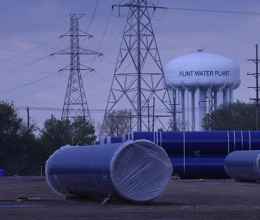The good news is that lead levels in Flint’s water continue to drop.
Unfortunately, the bad news keeps piling up.
Foremost, there is the fact that, 30 months after the disastrous switch to the Flint River and 10 months since the return to the regional water system, the water coursing through the aging pipes is still not safe to drink without first being run through a filter.
That’s particularly significant given that, with federal assistance exhausted, the state now is solely responsible for providing all the bottled water and filters residents need to use as long as the water remains unsafe. This reality, in turn, yields still more troubling news: As a Flint television station reported this week, the state fund that’s supposed to pay for all those bottles of water and filters will run dry by mid-October.
Worse still is the fact that there is still no telling when a permanent solution to Flint’s water crisis will be fully implemented: the replacement of as many as 20,000 lead and galvanized service pipes currently delivering water to Flint homes.
Situation Improving
The glimmer of good news came last week when Virginia Tech professor Marc Edwards, who played a pivotal role in uncovering the crisis last year, announced during a press conference that a new round of testing has shown a dramatic drop in lead levels compared to one year ago.
In August 2015, a small group of grassroots activists, along with the ACLU of Michigan, began working with Edwards and his team at Virginia Tech to conduct an independent sampling of water from nearly 300 Flint homes.
Those tests conclusively proved that lead levels far exceeded the federal action level of 15 parts per billion and were more than double what the city and state were claiming.
Since then, Edwards and his team, in an ongoing collaboration with residents, have twice analyzed water samples taken from many of the same homes tested a year ago. Using the 2015 samples as a baseline, Edwards has been able to track the progress of ongoing efforts to properly treat Flint’s water and re-establish a protective coating lining the insides of pipes. That coating was destroyed, and the pipes themselves badly corroded, when the state forced Flint to begin using the highly corrosive river water. Government officials then exacerbated the problem by failing to use mandatory corrosion control chemicals to prevent high levels of lead from leaching into the water.
During the 18 months that situation was allowed to exist, the damage done to the city’s water infrastructure was so extensive that recovery has taken much longer than originally predicted.
Watch Mark Edwards Discuss the Water Crisis in ACLU Video About Flint
Results from Edwards’ latest round of testing, using the EPA’s formula for evaluating lead levels in water systems, showed lead levels of 13.9 parts per billion – about half the level detected a year ago. But as Edwards himself noted, not all the homes he analyzed have been checked to guarantee they have either lead service lines or lead plumbing. For testing to be official, only water from homes verified to pose a high risk of lead exposure should be analyzed.
Until the city and state are able to show results of less than 15 parts per billion in tests that adhere to the EPA’s Lead and Copper Rule testing requirements, the city remains out of compliance.
“Things are getting better rapidly,” Edwards said in an email.
But it is still not safe to drink and use for cooking unless it is filtered.
And as long as lead pipes remain in the ground, people are at risk. That’s due, at least in part, to what Edwards has described as the “Russian Roulette” problem, which involves lead particles sporadically coming lose from pipes and causing levels in individual homes to skyrocket.
Water can test safe one day and pose a great risk the next.
Water Still Unsafe
“The Russian Roulette [threat] is a concern all over the US, and certainly in Flint,” said Edwards in his email.
That’s why Edwards – along with Flint Mayor Karen Weaver, the ACLU of Michigan, and others -- continue to call for removal of the estimated 15,000 to 20,000 lead and galvanized pipes (which can also be a source of lead) currently in place throughout the city. But work on that front has been painfully slow. To date, only 33 lead service lines have been replaced since work began in the spring. The city recently contracted with three companies to begin replacing another 250 lines at a cost of $1.2 million.
So far, the state has appropriated about $27 million to pay for service-line replacement. That falls far short of the $55 million Flint Mayor Weaver requested earlier this year to tackle the problem.
And even $55 million may not be enough considering that no one is certain how many pipes need to be replaced.
“It’s a complicated mess,” said Harold Harrington, president of UA Local 370, which represents plumbers, pipefitters, welders and service techs.
According to Professor Marty Kaufman, a water specialist who chairs the Department of Earth and Resource Science at UM-Flint, the city’s records are so unreliable that the only way to know for certain what material service lines are made of is to take the labor-intensive, time-consuming step of checking every property in the city.
Complicating things even more is the dilapidated condition of the overall water infrastructure, said Kaufman. He points out that many of the large water mains running under city streets are nearing the end of their 100-year life span, with ruptures occurring at a rate of about one per day. Those ruptures cause systemic disruptions that can shake lead particles loose, adding to the risk of exposure.
And, as Edwards had previously noted, the situation regarding aging water mains was exacerbated by the state’s decision to use the Flint River without applying proper corrosion control, taking about 12 years off of the life already decaying infrastructure.
The problems don’t end there.
Funds Drying Up
Until now, because a federal state of emergency had been declared, the U.S. government was footing most of the bill for providing residents with bottled water and filters; the state only had to cover 25 percent of the cost. But that state of emergency has expired, leaving the state on the hook for the entire cost, reported to be more than $117,000 a day.
This week, Flint television station NBC 25 reported that the $6 million allocated by the state to provide bottled water and filters will run out in about 50 days.
It is possible, that EPA-sanctioned tests will show that lead levels have dipped below the 15 parts per billion action level at that point, meaning that Flint water will be meeting federal Safe Drinking Water standards.
No amount of lead is considered safe. So what happens if the state decides that, once lead levels are considered to be technically in compliance with federal regulations, it will stop providing water and filters?
As of now, there’s no answer to that question.
But Jim Ananich, the state Senate minority leader and a Flint resident, is already arguing that residents shouldn’t be forced to use tap water that might fall below the federal action level but still contains what are generally considered unacceptably high levels of lead.
“The governor has already said that the federal Lead and Copper Rule isn’t good enough, and needs to be dramatically improved,” said Ananich.
Adding to his concern is the fact that replacing service lines is itself disruptive, and can cause temporary spikes in lead levels in areas where the work is being conducted.
“I don’t think there’s any logical way that you can say Flint’s water is going to be safe to drink in 50 days,” said Ananich. “We’re going to be in this for a while, and the state has the responsibility to rectify the situation.”
Curt Guyette is an investigative for the ACLU of Michigan. He can be reached at 313-578-6834 or cguyette@aclumich.org.
"(W)ith federal assistance exhausted, the state now is solely responsible for providing all the bottled water and filters residents need to use as long as the water remains unsafe. This reality, in turn, yields still more troubling news: As a Flint television station reported this week, the state fund that’s supposed to pay for all those bottles of water and filters will run dry by mid-October."

